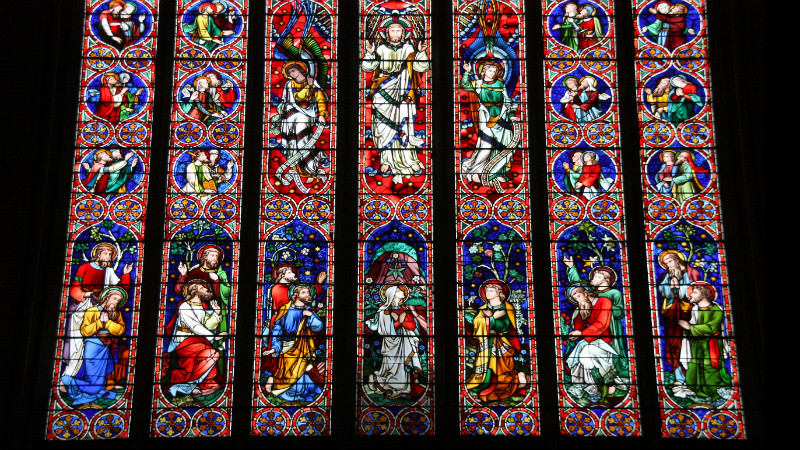Humidity monitoring lends a hand to stained glass preservation in St. Patrick's Cathedral
Vaisala HUMICAP® Transmitters monitor humidity and temperature to prevent condensation - the enemy of stained glass - in preservation applications. Condensation between window panes can be an unsightly annoyance to most people, but it can be the mortal enemy to historic art and artifacts, especially stained glass. Stained glass installed in buildings often requires protective glazing to guard it from impact damage and severe weather. Unfortunately, secondary glazing can create the ideal environment for lingering condensation on the stained glass surface. Condensation degrades almost all the materials used over the centuries to make stained glass. Among the most vulnerable is the glass paint that defines the artwork, modulates the light, and imparts its most breathtaking quality – vivid color.
In the case of the St. Patrick’s Cathedral in New York, improving preservation of the French, English, and American stained glass windows is a part of a major restoration. The project started with an initial three-year planning phase that is expected to be completed in 2010, with the restoration work taking place over the following three years. The project includes complete restoration of the interior and exterior of the marble building, a new central mechanical plant, new mechanical, electrical and plumbing infrastructure, expansion of the Parish House and renovation of private areas.
Fighting back with science
Arthur Femenella, President of New Jersey-based Femenella & Associates, is part of an international team of distinguished stained glass restoration experts who are developing a strategy to extend the life of the Cathedral’s stained glass. Femenella is recognized around the world for his expertise in conserving and restoring stained glass made by artists such as Louis Comfort Tiffany, John LaFarge, and Frank Lloyd Wright for a long list of institutional and private clients. With an education in physics and nearly 40 years of experience in stained glass restoration, Femenella’s expertise connects the art to the science of preservation.
Disarming the enemy: controlling humidity and temperature
Stained glass restoration experts in Europe and North America have been moving toward the use of isothermal protective glazing to protect stained glass from vandalism, weather, and insidious condensation. According to Femenella, “The goal of isothermal glazing is to have the same humidity and temperature inside the building and in the interspace between the stained glass and the protective glazing.” This can be achieved by proper venting of the interspace to the interior of the building, which transfers the potential for condensation forming on the stained glass to forming on the protective glazing instead.

Espionage: Vaisala selected for active monitoring
The challenge for Femenella’s team was to design and evaluate the site-specific venting and glazing techniques that will best prevent condensation on the Cathedral’s stained glass surfaces. The team built six different models of protective glazing and installed each on the outside of a vertical window– called a lancet – to determine which glazing models would perform to specification over one year. Femenella selected Vaisala HUMICAP® Humidity and Temperature Transmitters to actively monitor the interior, interspace, and exterior conditions of the six glazing models installed on the lancets. His selection of Vaisala was based on the products’ reputation as being extremely dependable. The test area was fitted with one wall-mount humidity transmitter on the inside of the building, one humidity transmitter with remote probe in the interspace between the stained glass and the protective glazing in each of the six lancets, and one Vaisala HMD60YO on the exterior. The data is being collected every 10 minutes, 24 hours a day, for one year to fully evaluate the effectiveness of the glazing models during all seasons. The performance of the Vaisala units impressed Femenella immediately.
“We were pleased at how quickly the transmitters identified the various microenvironments,” he says, adding that they have proven to be “very good devices” to help define the best protective glazing techniques. Similar tactics are used in HVAC systems in museums, as they need to manage a very stable environment of specified humidity and temperature that preserves art and artifacts.
Evolving preservation strategies
The Vaisala transmitters have been gathering data for the first three months of the 12-month test period. Based on very early observations, Femenella reports that the team is “leaning toward full isothermal installation,” but the information needs to be collected for a full year to optimize the venting design. Femenella believes active monitoring will help change the way stained glass is preserved in the United States. The Vaisala sensors have allowed the team new visibility into the microenvironments of the windows, which will result in more effective, window-specific designs of isothermal protective glazing.
The improved design and installation of the most effective protective glazing may delay major stained glass restoration and re-leading for many years – perhaps hundreds of years. Along with more effective protective glazing designs, continual monitoring of the humidity and temperature can serve as proactive preservation by alerting conservators to problems that they could not otherwise identify as quickly.
